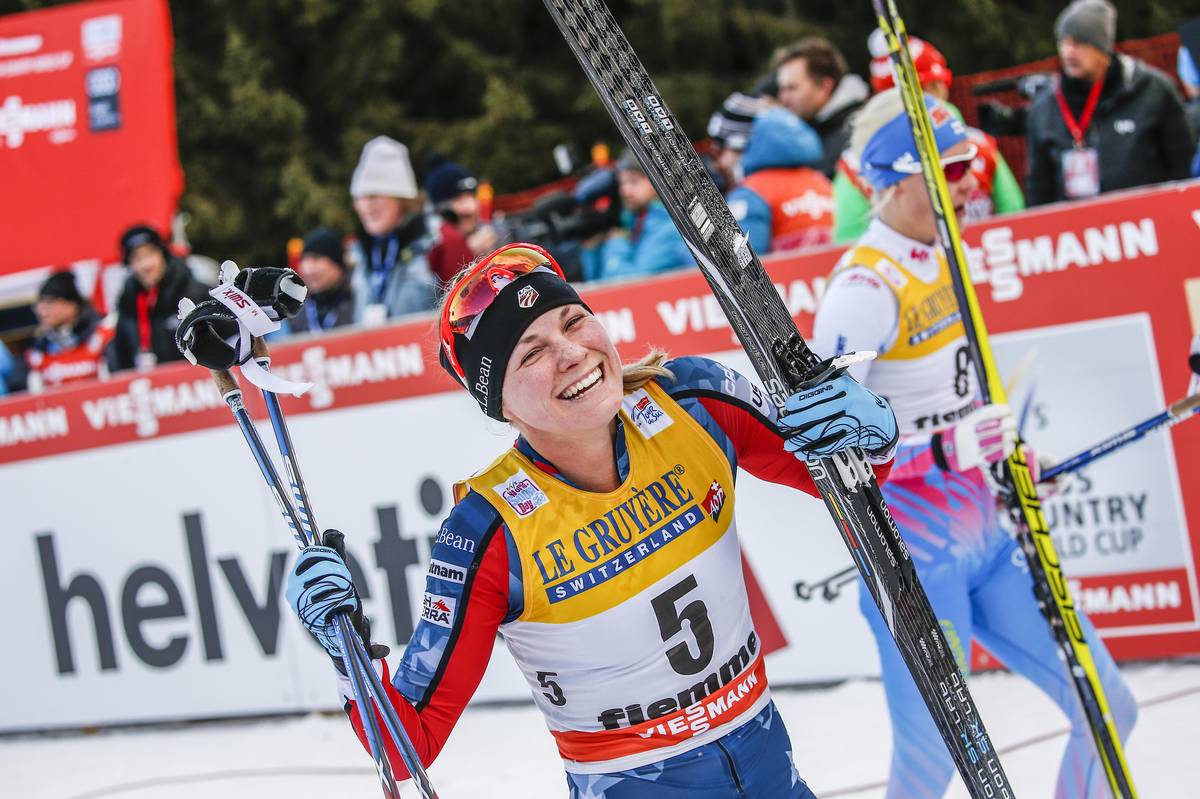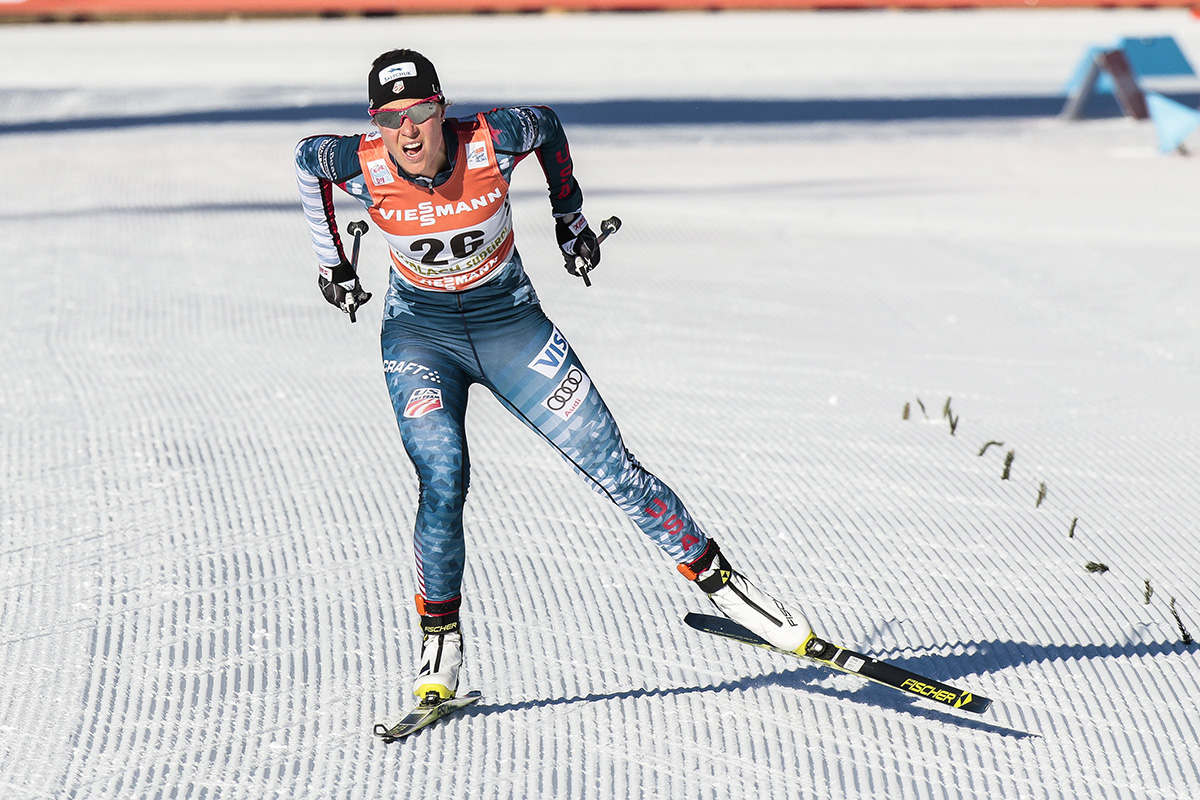
Last Thursday, U.S. Ski & Snowboard sent out a press release detailing the U.S. contingent for the upcoming Tour de Ski which begins this Saturday, Dec. 30, with a freestyle sprint in Lenzerheide, Switzerland.
In non-Olympic and non-World Championships years, the Tour de Ski (TdS) stands as the highlight for many all-around World Cup athletes and fans. This year’s U.S. team for the TdS includes four men and seven women, all current members of the U.S. Ski Team (USST): Sadie Bjornsen, Rosie Brennan, Sophie Caldwell, Jessie Diggins, Kikkan Randall, Ida Sargent, Liz Stephen, Erik Bjornsen, Paddy Caldwell, Simi Hamilton, and Andy Newell. (Here’s a list of some TdS teams from other nations.)

In an Olympic year, a seven-stage tour over nine days may not fit into every top skier’s race plan. A long tour event might tweak the body in ways that make peaking for the Olympics in mid-February untenable. While for others, the grind of the TdS offers an opportunity to ski into top-shape race fitness.
Here in the U.S., TdS starts have become a topic for discussion due to the small fields finishing last year’s edition of the tour — which was a World Championships year. The argument goes that in smaller fields, it’s easier to score valuable World Cup points by finishing in the top 30 of a given race. For example, in last season’s TdS, 31 women and 40 men completed the final stage. The year before — a non-championship or Olympic year — 43 women and 52 men finished that final climb atop the Alpe Cermis in Val di Fiemme, Italy.
For both World Championship and Olympic selection criteria, results in specific World Cup races and/or rankings on the distance and sprint World Cup lists can determine if a skier meets the USST’s objective qualifying criteria. In other words, if a U.S. skier on the World Cup does not lock up an Olympic spot during Period 1, their Olympic qualification may be determined by points scored during the TdS. It goes without saying that while the USST members at the TdS solidify their Olympic nominations, many other domestic-based skiers vying for Olympic-team nods will be racing at the upcoming U.S. Cross Country Championships in Anchorage, Alaska, which start next week.
Here’s a link to the current U.S. Ski & Snowboard 2017/2018 Cross Country World Cup Team Selection Criteria (Updated 11/10/17)
FasterSkier emailed U.S. Ski Team Head Coach Chris Grover on Dec. 23 with the following questions regarding the selection of this year’s TdS team:
FasterSkier: Starting with those that aren’t racing: Was Scott Patterson offered a spot that he decided not to take? What are his plans over the next few weeks?
Chris Grover: As you may recall, we added some guidelines to the 2018 World Cup Selection criteria this fall prior to the start of the season in order to better define to the community how we would utilize discretion picks to World Cup, including the Tour de Ski. The guidelines are:
Athletes who have not met the General Criteria may be selected to the team via discretion if they satisfy any of the following:
- Outstanding competition results from the 2016/2017 or 2017/2018 seasons, including as a member of a team event, indicating a potential for Olympic success.
- Recent positive direction or trend of competition results indicating a potential for Olympic or World Championship success.
- Indication of medal potential in future Olympic or World Championship competition (such as international age group results and age rankings) that would be materially enhanced by selection to the team.
We did offer Scott a Tour de Ski start. He is a young athlete on his first season of World Cup and we would like to see him build his experience on the Tour. The discretionary pick would have utilized the third bullet point above. Scott chose to return to Anchorage for Nationals because he felt his chances of qualifying for the PyeongChang Team were better there. Scott is currently training in Bozeman and will head to Anchorage next week.
FS: Was Chelsea Holmes offered a spot on the tour roster? If not, what were some of the reasons or considerations taken into account for that decision?
CG: Chelsea was not offered a TdS start, as much as we would have liked to see her start there. She did not meet any of the above guidelines, so it was important for us to adhere to the guidelines and have her compete in Anchorage against the SuperTour field for the additional PyeongChang selections.
FS: Was Noah Hoffman offered a spot? If not, what were some of the reasons or considerations taken into account?
CG: Noah was not offered a TdS start. Same rationale as Chelsea.

FS: Of the 11 athletes racing the TDS, which plan to complete the tour in its entirety? And for the sprinters that don’t plan to do the whole tour, what stages do they plan to complete?
CG: Jessie, Sadie, Liz, Rosie and Paddy are targeting the entire Tour. Andy, Simi, Sophie, and Ida will either stop after Stage 4 or Stage 5, and then rest and begin preparing for Dresden. Erik will probably decide during the Tour how far he will go and may stop after stage 5 to also prepare for Dresden. Kikkan had originally planned on only racing the first 3 stages in Lenzerheide, but her plans may be evolving.
FS: This summer you mentioned that the standard for scoring points in the TdS would not be as “easy” this year as in past years because you anticipated that “this year you’re going to have much better numbers of athletes that are actually finishing the Tour.” Do you still believe this?
CG: Yes. Last spring, we expanded the start quotas for the Tour de Ski. Now the top-20 women and top-20 men in the Sprint World Cup are additional quota spots for the Tours. This means that the nations don’t have to wrestle with a decision about whether to take one of their best all-around or distance skiers to the Tour versus a sprint athlete currently ranked in the top-20 who may be fighting for a top year-end ranking in the sprint World Cup. They can take them both. Last year’s Tour only included one sprint; this Tour has two sprints. The pure sprinters may still drop-out after the second sprint, but their respective countries may have brought additional distance skiers that are planning on skiing the entire Tour. When it comes to total numbers of athletes left standing at the end of the Tour, the x-factor is always illness, and whether athletes and Teams have managed to stay healthy. Occasionally a bad cold or flu will circulate through the TdS field and it’s not uncommon to see an entire Team contract the virus. These health scenarios are impossible to predict.
FS: You also mentioned that it is “an easier path for an athlete to make the Olympic team” via podium finishes at U.S. nationals than by surviving to the end of an attrition-ravaged TdS. In light of the numerous top athletes who have said they will be opting out of this year’s pre-Olympics TdS, do you still believe this?
CG: Yes. I still believe that there is more opportunity for USA athletes that are skiing fast competing against a domestic field at US Nationals that doesn’t include the USA TdS athletes, then there is fighting to stay healthy and score points at the Tour itself. However, both paths require an athlete to be skiing fast, which is clearly the goal of the selection process.
FS: For those athletes who are doing the TdS, how do you see that fitting into their season-long preparation and goals, either for the Olympics or otherwise?
CG: Those athletes that are targeting the entire Tour generally see the Tour as a way to build peak race fitness. When followed by adequate rest, these athletes have looked to the Tour to sharpen race fitness and help them prepare for a major Championships in February. For the very best athletes the Tour has also been a place for stand-out results, podiums, and gathering critical World Cup points for those hunting for top season-end Overall, Distance, or Sprint rankings.
FS: Do you foresee a time when the TdS is no longer held during Olympic years?
CG: That’s doubtful. The Tour de Ski is by far the most popular Cross Country TV spectator and fan event of the season for the FIS. It is only rivaled by the Olympics and World Championships. As long as there is massive fan interest, and a lot of prize money and World Cup points on the line, the athletes and the teams will be there.
Jason Albert
Jason lives in Bend, Ore., and can often be seen chasing his two boys around town. He’s a self-proclaimed audio geek. That all started back in the early 1990s when he convinced a naive public radio editor he should report a story from Alaska’s, Ruth Gorge. Now, Jason’s common companion is his field-recording gear.



